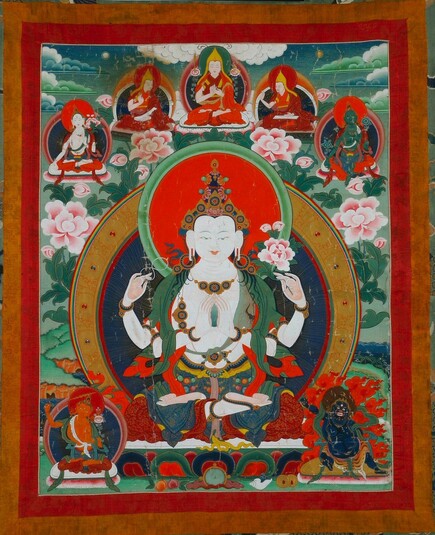
Item: Avalokiteshvara (Bodhisattva & Buddhist Deity) - Chaturbhuja (4 hands)
| Origin Location | Tibet |
|---|---|
| Date Range | 1800 - 1899 |
| Lineages | Gelug |
| Material | Ground Mineral Pigment on Cotton |
| Collection | Private |
Alternate Names: Lokeshvara Avalokita Lokanata Lokanatha Mahakarunika
Classification: Deity
Appearance: Peaceful
Gender: Male
Avalokiteshvara, Chaturbhuja Sadaksari (Tibetan: chen re zi, chag shi pa yi ge drug pa. English: the All-seeing Lord with Four Hands, Having Six-syllables): the great bodhisattva of compassion, with four hands representing love, compassion, joy and equanimity. Held in the main pair of hands at the heart is a blue wish-fulfilling jewel. In the upraised right is a crystal mala of beads and in the left a pink lotus blossom.
"As the nature of all buddhas, Avalokiteshvara, in colour like stainless conch and crystal, very resplendent, smiling, peaceful and radiant. With four hands the first are folded at the heart, the lower hold a crystal mala and jewelled lotus, two beautiful feet seated in vajra posture, adorned with many attractive silks and jewels, beautified with dark blue hair in tufts [some] loose. On the crown of the head, the wisdom of all buddhas, is the Lord, source of all refuge gathered as one, in essence the Guru in the aspect of Amitabha, in the manner of the Lord of the Family, seated happily." (Ngorchen Konchog Lhundrup 1497-1557).
At the top center is Lama Tsongkapa with the two main disciples Gyaltsap Dharma Rinchen to the left and Khedrup Geleg Pal Zangpo to the right. On the far left is the goddess of long-life White Tara and on the right Green Tara. At the bottom left is the bodhisattva of wisdom Manjushri and on the right the wrathful bodhisattva Vajrapani. Combined as a triad the three deities of Avalokiteshvara, Manjushri and Vajrapani are known as the 'Rig Sum Gonpo' - Lords of the Three Families, representing the body, speech and mind of all buddhas of all times, past present and future. This designation arises from the Kriya Tantra, the first of the four classifications of Tantra in Vajrayana Buddhism.
Avalokiteshvara is the patron bodhisattva of Tibet and is practiced by all traditions. There are numerous Sarma lineages and different forms of practice which span all four tantric classifications as well as uncounted Kama and Terma (treasure) traditions from the Nyingmapa School.
Jeff Watt 9-2000
Tradition: Gelug Deity Paintings
Collection: Private 1
Buddhist Deity: Avalokiteshvara Main Page
Collection of Asian Art Museum of San Francisco
Buddhist Deity: Avalokiteshvara, Chaturbhuja - Four Hands - Main Page

